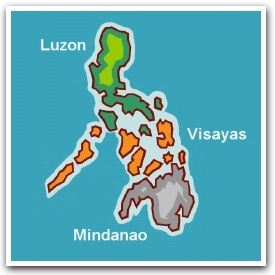

Daily Life :: Food
- LUZON
- Northern Luzon: Cooking method is simple; vegetables are usually steamed or boiled. There is a preference for locally grown vegetables e.g., saluyot, a leafy green that looks like spinach but turns slippery like okra when cooked.
Some popular dishes are pinakbet and bangus (milkfish) which are farmed in ponds of brackish water. - Central Luzon: Cooking is marked by elaborate preparation and clever combination of many different ingredients in a single dish.
The people have a passion for meat especially pork and poultry. Some popular dishes are sisig, embutido and balut - a partially formed duck embryo in an egg that has been boiled for a few moments.
They usually like their vegetables sautéed in garlic, onions and tomatoes with pork and shrimps. - Southern Luzon: The people have a strong preference for fresh water fish which abound in streams and rivers. Vinegar seasoned with garlic, salt and pepper is used as a marinade for fish before frying or as a dip.
Its cooking is notable for their generous use of coconut milk, chilies, vinegar and tamarind. Some popular dishes are sinigang and laing.
Well-known native cakes and delicacies include suman and bibingka. - VISAYAS
- MINDANAO

The region is noted for dried salted seafood. Visayan cooking tends to be salty because of its dried salted foods and the liberal use of guinamos. Cooking is also simple. The people like their fish broiled over live coals or boiled in vinegar until it is almost dry. Some even eat their fish raw as in kinilaw.
Like the Northern Luzon people, they also like their vegetables simply boiled or steamed but dipped in guinamos with a squeeze of lemon.
The region is also well known for its native snacks such turon, turong saging and baybaye.
Mindanao cooking is marked by simplicity and the non-use of pork which Muslims do not eat. It is closely similar to Indonesian and Malaysian native fares in the use of hot chilies and spices such as curry. Some popular dishes are tiola sapi, piarun and lapua.
For staples, most Filipinos living in Luzon prefer rice while Visayans like corn. In Mindanao, however, panggi (cassava) is the staple food in many areas.